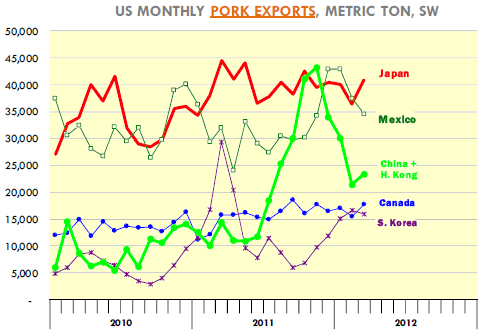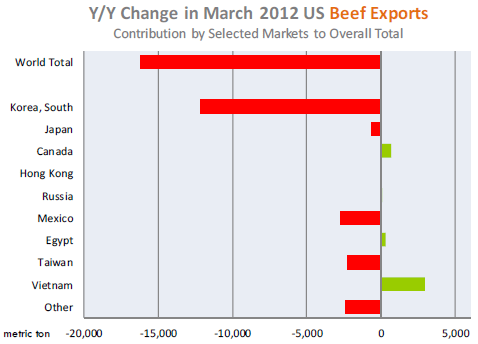



CME: Continued Strong Growth in US Pork Shipments
US - Headlines about US beef and pork exports in March highlighted the continued strong growth in US pork shipments. while also noting the 20 per cent pullback in US beef exports compared to the previous year, write Steve Meyers and Len Steiner.Looking at the details,
however, the picture is a bit more complicated. It is important to
note what econ professors never get tired of repeating: higher
sales do not mean higher demand. The law of demand says
that consumers will take more quantity at a lower price. We
simply move down the demand curve as supplies change.
US
pork producers continued to ship big quantities of pork to the
rest of the world in March of 2012, however, prices had to adjust
lower in order to keep up this level of shipments. Case in point
are ham exports to Mexico, the largest export market for this
item. Shipments of ham to the Mexican market in March were
some 50 per cent higher than a year ago while ham prices in the US
market in March declined some 15 per cent from the previous year.
In
the last quarter of 2011, we saw a real increase in demand for
US pork from China. Exports to China/Hong Kong have slowed
down in recent months, reflecting both the seasonal decline in
demand in China (post Chinese new-year in Jan) but also increasing
pork supplies and lower prices in the Chinese market.
Shipments of fresh/frozen pork to China/Hong Kong in March
were 23,340 MT, about 63 per cent higher than the comparable month a
year ago but still about 46 per cent smaller than what they were in November
(see chart).

Exports to Mexico have picked up as lower
prices have encouraged higher shipments. Total US pork exports
to Mexico in March were 34,535 MT, 8 per cent higher than a year ago.
Monthly US pork exports to Mexico in Q1 on average were 18 per cent
higher than a year ago. Exports of fresh/frozen pork to Japan in
March were 40,870 MT, about 8 per cent lower than a year ago. The
current level of shipments remains in line with the overall average
that we saw from a year ago.
The Japanese market is quite
mature and while it accounts for about a quarter of all US pork
sales, it does not represent a source of growth. Exports to S. Korea
were about 46 per cent lower than a year ago when an Foot and
Mouth disease outbreak caused supply shortages and increased
demand for US pork. However, the current level of shipments
(+15000 MT) still represents a 60 per cent increase from the volume
shipped in the second half of 2011.
Beef exports in March were lower, largely due to the
reduction in shipments to S. Korea. US exports of fresh/frozen
beef and veal to S. Korea in March were 9,912 MT, 55 per cent lower
than a year ago. Still, at around 10,000 MT a month, current shipments are in line with the volume that was exported in the
second half of 2011.
Exports to S. Korea will benefit from the
Free Trade Agreement but could be hampered in the short term
by a surging US dollar. Total beef and veal exports for the month
were 64,601 MT, 20 per cent lower than a year ago. The reduction in
exports to S. Korea accounted for about 75 per cent of the decline. Exports
to Mexico remain weak, with shipments down 19 per cent from a
year ago.








